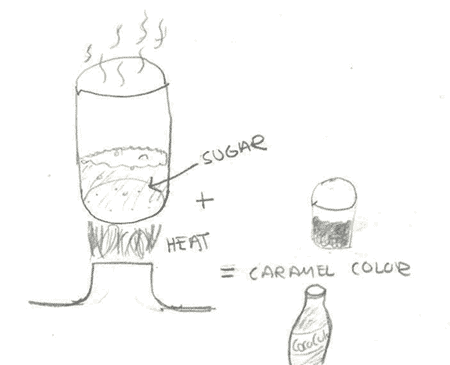I’ve recently talked a little bit about Mexican Coca-Cola, which is sweetened with real sugar. A reader alerted me that my advocacy of Mexican Coke glossed over the ingredient known as “caramel coloring”.
If you read through ingredient labels as often as I do, you know that caramel coloring is pervasive in foods. Widespread use makes caramel color the most popular food color additive available.
Making caramel color
Creating the color additive is as simple as caramelizing (heating) sugar. Sugar, in this sense, might mean a glucose syrup (like corn syrup), or another form of simple carbohydrate. Carefully applying heat will yield a bitter amber liquid that smells like burnt sugar. That’s caramel color.

Types of caramel color
Several types of caramel color are produced and used in food products. 60-70% of all caramel coloring falls into Class IV, which is a dark additive used in soft drinks and other acidic environments. Class IV caramel coloring contains sulfites, which some people may have sensitivity to.
Class III caramel coloring is lighter than Class IV coloring, and is often referred to as brewer’s caramel because beer manufacturers use it when creating darker ales.
Health risks of caramel coloring
Caramelization changes the structure of a sugar, meaning that it’s a tad different. This difference could have an impact on health.
Caramel coloring is approved by the FDA for use without certification in food products. In other words, the FDA believes caramel coloring to be generally safe for human consumption (though there certainly other things on that list I avoid, like HFCS).
No known health risks exist for caramel coloring, though one study suggested that caramel coloring (in high doses) could induce hypertension (this seems to be pure speculation, though). A handful of websites criticizing caramel coloring have incorrectly interpreted those studies.
We can’t really say, however, that caramel coloring has been proven to be safe. We just know that it has been used for a very long time. A thorough, longitudinal study on the effects of caramel coloring would be a nice addition to the literature.
Is caramel color natural?
Generally, yes. Caramel color is derived from natural sources (sugar or corn). But so are compounds like high fructose corn syrup.
Certainly, the form of sugar used in creating the caramel color will be a refined product. It’s natural, but about two steps away from a natural state of existence.
Caramel color and caramelization have been around for ages, though the additive that makes Coca-Cola dark probably arrived through a modern production process.
So, will you continue consuming caramel color?
Yes, though I’ll be more acutely aware of the volume of caramel color I’m putting into my gullet. The most significant natural-food drawback is that caramel coloring is produced from a refined sugar product; this is something we should generally try to reduce in our diets.